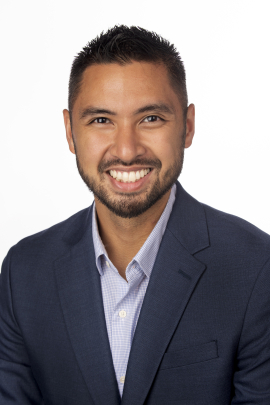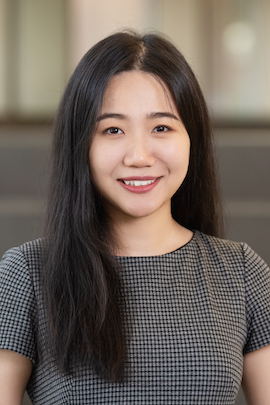Amy Sprague
August 11, 2025
“ISE welcomes two exceptional faculty members whose research tackles some of society's most pressing challenges. Assistant Professors Gian-Gabriel Garcia and Dan Li bring expertise in healthcare analytics and cyber-physical security, strengthening the UW's position as a leader in applied engineering research.” – ISE Chair Juming Tang
Assistant Professors Gian-Gabriel Garcia and Dan Li join the ISE faculty, bringing expertise in healthcare analytics and cyber-physical security and strengthening the University's position as a leader in applied engineering research.
Gian-Gabriel Garcia: Bridging prediction and optimal decision-making in healthcare

Assistant Professor Gian-Gabriel Garcia
Garcia joins the UW from Georgia Tech with a clear mission: developing mathematical frameworks that help healthcare providers make better decisions for their patients. His research sits at the intersection of prediction and optimal decision-making, using sophisticated models to tackle complex medical challenges.
"We're not just building algorithms," Garcia explains. "We're creating frameworks that help healthcare providers make better decisions for their patients while ensuring those decisions are fair, interpretable, and actionable."
Garcia's work spans an impressive range of healthcare applications, from his foundational research in sports-related concussion to chronic diseases including hypertension and diabetes. His recent projects explore opioid crisis interventions, maternal health outcomes, and pediatric care—both mental health and clinical deterioration monitoring.
His approach features interdisciplinary collaboration. When Garcia first began working on concussion research during his doctoral studies, he thought he'd focus on optimizing the timing of return-to-play decisions. But working closely with Professor Steve Broglio at the University of Michigan opened his eyes to more fundamental diagnostic challenges.
"What we found out was that if you take a couple of steps back, there were a lot of questions related to the diagnostics of concussion that were actually more at the forefront of what people were interested in," Garcia recalls. This collaboration led to research on uncertainty in concussion diagnosis—moving beyond simple yes-or-no classifications to "possible, probable, definite" frameworks that better reflect the complexity of the condition.
That early research, which was later cited in an American Medical Society for Sports Medicine position statement, taught Garcia a crucial lesson about the value of working closely with clinicians. "If you work on really important problems and work closely with clinicians, your work can actually make an impact," he says.
Garcia's hypertension research demonstrates how prediction and optimization work together in practice. His models first predict a patient's risk of adverse outcomes like heart attack or stroke, then estimate how different treatments might affect their disease trajectory. Finally, optimization algorithms leverage these predictions to determine the best treatment approach for each individual patient.
He looks forward to working with local practitioners here in Seattle, "I think it helps make sure that even though, for someone like me as an engineer who really likes the math and technical challenges, we're solving real problems that have practical impact."
Dan Li: Securing our cyber-physical future

Assistant Professor Dan Li
Li arrives as an expert in cyber-physical security, bringing crucial expertise to protect the interconnected systems that power modern life. Her research focuses on a specific but critical threat: cyber attacks that target physical processes through digital networks.
"What I do is help people translate their cyber vulnerabilities into physical outcomes," Li explains. "With these vulnerabilities sitting in their manufacturing line, what's the worst case that can happen to their physical manufacturing process, to their product quality, to their system reliability?"
Li's work addresses cyber-physical attacks—sophisticated threats that intrude through cyber networks but aim to manipulate normal operations or cause physical damage to equipment. These aren't typical data theft scenarios, but rather attacks motivated by geopolitical tensions, commercial competition, or insider threats that can have devastating real-world consequences.
Her research approach combines mathematical modeling with practical applications. Li develops generic frameworks using state space models and graph-based representations, then creates optimization problems that mimic attacker behavior—maximizing physical impact while minimizing effort. This allows her to determine worst-case scenarios for any system that can be represented by her models.
The threat is real and growing. Li points to the famous Stuxnet malware attack on Iran's nuclear facilities as a prime example. The attack, which began around 2009-2010, used malware distributed through USB drives to reprogram centrifuges, increasing their rotation speed for an unnoticeable period of time and causing over a thousand centrifuges to fail within a year.
"The plant operators actually didn't figure out it was a cyber attack because their centrifuges had bad quality," Li explains. "They treated it as normal faults, and nobody thought it could be a cyber issue." The attack's sophistication and scale—affecting over 100,000 machines—demonstrates the potential reach of well-resourced cyber-physical attacks.
Li's approach emphasizes resilience by design rather than reactive patching. "Understanding what these digital communication channels that you're building means to your physical processes" is crucial when implementing new technologies like AI-based control systems, she says.
Strengthening UW's engineering leadership
Both Garcia and Li chose the UW for its exceptional research infrastructure and collaborative opportunities. Garcia praises the university's investment in healthcare research: "For someone who's really interested in doing state-of-the-art research in healthcare that sits on top of machine learning and AI and optimization, I don't think you can really beat UW."
Li is excited about Seattle's unique manufacturing ecosystem with players who already take cyber-physical security seriously. She says, "Many industry partners here don't need persuading about the importance of this work. They've already internalized the possibility of these threats."
ISE Chair Juming Tang shares his enthusiasm, "ISE welcomes two exceptional faculty members whose research tackles some of society's most pressing challenges. Assistant Professors Gian-Gabriel Garcia and Dan Li bring expertise in healthcare analytics and cyber-physical security, strengthening the UW's position as a leader in applied engineering research."